Back in 1963 would anyone have laid a bet on a go-faster Beetle whose design layout defied the laws of physics becoming the longest lasting and arguably most revered sports car of its era?
That, remarkably, is the tale of the Porsche 911. Celebrating its 50th anniversary this year.
Launched into the middle of the Swinging Sixties – with that wavering rear end, that is somehow rather appropriate – as the successor to the 356, the 911 had a lot to live up to. Designed by Ferdinand ‘Butzi’ Porsche in 1959, the goal was to move the 356 game on by offering a more sophisticated, comfortable and powerful car that would, crucially, be more expensive and therefore more profitable. Launched initially as the 901 – until Peugeot protested – the 911 was unveiled at the Frankfurt Motor Show in 1963 and production began in September 1964. With the familiar Porsche rear-mounted, flat ‘Boxer’ engine configuration, the 911 replaced the 356’s swing axle with an independent set up. Aerodynamic styling and a low weight meant decent acceleration and a high top speed from the small 2 litre 130 bhp six pot engine.
[popup-slideshow id=17718 text=”Click to watch our 911 50th Anniversary Slideshow“]
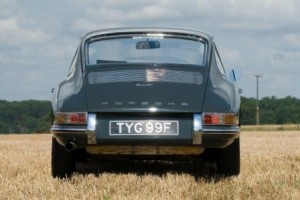

The 911’s reputation as a widow maker probably dates back to these early cars. With a short wheelbase, low front end weight and a decent turn of speed it didn’t take much to create 911-shaped holes in hedges as the back end took on a mind of its own in the event of sudden changes of direction or speed, such as when cornering. Yet in a strange way, this dogged waywardness and singular commitment to an alternative sports car vision sealed the success of the 911. The car quickly became one that you had to master – the contemporary view was that those 911 hedge re-designers were drivers who couldn’t handle a 911; to successfully tame the car was a signal of its success. Porsche’s success with racing versions of its road cars helped reinforce this argument.
Inevitably, though, Porsche had to do something or else the 911 risked becoming a niche car for petrolheads. So it lengthened the wheelbase in 1969, created the B-Series cars and added more power. At Great Escape Cars we have one of these early cars, a 2.2 911T – there were initially three performance levels, T, E and S – and it is an absolute joy. There is something pure and honest about these early cars that later cars somehow lack, despite their considerably improved performance and handling.
I have had the good fortune to drive both short chassis and long chassis early cars. The earlier car is remarkable for its solidity and pliant ride but I will offend purists by saying that to drive it feels like a low-slung Beetle. It also, in my view, doesn’t look that great either – it’s too short, which makes the car look hunched and, frankly, rather beetle-like. The handling also isn’t much cop – you can throw it around far more than you might expect but the lack of power and persistent sense of a heavy pendulum hanging out the back of a short body hinders ultimate enjoyment.
The long chassis 911 is a revelation by comparison. The extra length in the wheelbase transforms the appearance, making the car longer (obviously), lower and much more sporting. In a decent colour you can relish the attention to detail that lies behind each panel. The extra engine capacity and horsepower also make it much more fun to drive – the early cars are no firebrands but they are plenty quick enough, delivering a healthy shove when you plan your foot. The extra length transforms the handling – the B Series car feels considerably more sure footed and clings and points as you would expect of a sports car.
The search for extra power that was laid down with the first B-series cars set the template for the next 20 years as Porsche progressively launched ever more powerful versions of the basic 911 concept, a progression that not only furthered the 911 legend but also improved Porsche’s profitability. This culminated in the 1980s with the whale-tail turbo-charged models, a development that arguably saved the 911.
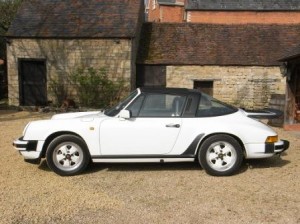
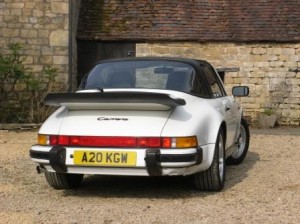
The 928 was intended to replace the 911. It was bigger, more comfortable and more practical. But it wasn’t a 911. The 928’s rather poor reception forced Porsche to refocus on the 911 in the early 80s. It responded by creating the wide body 911 Turbo. So then, a 330 bhp rear engine, rear drive car with an enormous rear spoiler and invariably bright red paintwork. The 911 Turbo hit the 80s zeitgeist full on and became the four wheeled plaything of choice for aspiring City types, a role it has never quite shaken off in the 30 years since.
To capitalise on the unexpected popularity of the 911 Porsche sprinkled a little Turbo stardust on its lesser models. In came big colour coded bumpers and an array of options that included white wheels and that tea-tray spoiler. Some of the changes were technical rather than cosmetic, including a new gearbox that for aficionados transformed the slightly clunky shift of the early cars.
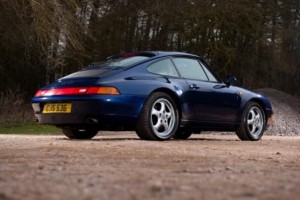

The Targa was different again. The 3.2 litre engine is barely discernible from the 3 litre, offering about the same power and similar delivery. In all other respects, it drove like the coupe. The problem for me was that Targa roof. It niggled me for two reasons. Firstly, it squeaked and rattled a lot and there was a lot of scuttle shake. But more importantly, it ruins the 911 shape. From what I could see all of that was to no particular advantage because the removable roof achieves little more than the sunroof did that was fitted to the coupe.
Porsche persevered with the original 1963 car until 1989 when it launched the 964. The new car was probably a response to the success of the 1980s 911 and the failure of the 928, being both softer and more upmarket than the car it replaced in order to bridge the gap left by the 928. The 964 didn’t get a great reception from the press, who felt it had lost some of its purity, but it did herald major innovations including four wheel drive and a Tiptronic gearbox (early 911 had the option of a ‘sport-o-matic’ box, much derided and not just because of its silly name). Many of these developments were taken from the 959 supercar.
The final air cooled cars were the 993 series of 1994 to 1997. Retaining the middle section of the original car, Porsche grafted on a new front and rear and installed a new multi-link rear suspension system that was claimed to finally banish the 911’s tail-happy tendencies to the dustbin of the past. Larger capacity engines and more power also continued a common theme.
The late 993 cars are growing in stature because many see them as the ultimate incarnation of the air-cooled 911. They are quick cars but not supercar-quick, as would happen with later models. They also retain the diminutive proportions of the classic 911. For enthusiasts, a decent 993 is a good combination of modern reliability with classic Porsche design. We have a 993 on the fleet and there is a lot to recommend it – the rear suspension does significantly improve the car’s surefootedness although to my mind the extra power and the technological advances rather cancel each other out in terms of the actual experience. It goes faster and handles better than the 1969 car but is it actually more fun to drive? I’m not sure…
By the late 1990s Porsche had pushed the original 911 concept to breaking point. Compared to the competition the car was small, a bit noisy, not entirely relaxed when cruising on the motorway and generally felt like an exercise in technological development that had reached its zenith.
All hail the 996. Lets be clear – the 996 and its subsequent water cooled siblings are great cars. They share the same mechanical layout as the early cars but they are light years away from them in every respect, from performance to appearance and comfort. It had to happen, nobody wants a 1960s car in 2013.
The new car didn’t meet with a great reception, mainly because of its looks. Whereas the original 911, right up to the 993, was small and delicately styled, the 996 was big, wide, long and chunky. It clearly owed its style to the 911 but this was the 1960s car’s lardy cousin. Critics disliked its similarities to the Boxster and its plain interior.
[popup-slideshow id=17718 text=”Click to watch our 911 50th Anniversary Slideshow“]
Of course the car was a massive success. The market wanted a bigger and more comfortable 911 with much more street presence. Porsche still offered the stripped our high performance versions for the die-hard fans, but the bulk of its sales were to people who would never dabble with opposite lock. Perhaps in that sense Porsche was just repeating the trick it pulled in 1969 when it launched the tamed long chassis B Series.
With the 996 Porsche seriously went to town with the technological advances and the performance variations. The car was bigger and significantly more powerful than the 993, shunting the 911 into a new supercar market space that left room for the cheaper Boxster and Cayman.
The 996 lasted until 2005 when it was replaced by the 997. This car reintroduced some of the classic 911 design cues, including the bug-eye headlamps and styling cues from the 993. Altogether, it was a better looking car. Still big and wide and technically very similar to the 996 but the styling changes made it easier to love.
The 996/997 platform was replaced last year by an entirely new design, the aluminium 991. It moves the game on technologically by being light and fast – something the 996 and 997 cars hadn’t quite mastered – and it still looks like a 911. Undeniably the 991, and its 996 and 997 forefathers, are brilliant cars. They do what they do uniquely, and in a world of homogenised sports cars that is no mean feet. They also, in that sense, stay true to the original 911 concept of technological innovation and superiority. All that in a car that you can happily travel 500 miles in and get out feeling refreshed. Not something you can say about the first short-chassis 911, whose offset pedals are at best challenging to comfort. And your ability to walk afterwards.
So what to make of 50 years of the 911? It is testament to Porsche’s singular vision that it has managed to keep the basic 911 format alive and relevant right up to the present day. Whichever 911 you prefer it is fair to say that each one has been relevant and extremely popular with contemporary customers. The later cars may be bigger, heavier and much, much quicker than the first cars, achieving their power through large capacity engines, but they have to be because that what people want to buy.
Your favourite 911, ultimately, says more about you than the car. Personally, I’m not keen on driving a car that I can only really enjoy on a race track. That’s why I’ll stick with the B-Series cars of the late 60s and early 70s. This isn’t about some sort of automotive hairshirt – I simply enjoy their real-world performance, their lightness and their tactility.
So here’s to the 911. You’re 50 and, with your new 991 shape you’ve lost some weight and regained your looks. What an achievement. Cheers!
Porsche 911 trivia:
- 820,000 911s made since launch in 1964
- 3 basic models produced in 50 years (2 up to 2012)
- Porsche expected to build no more than 500 air cooled turbos. It built 32,335
- Porsche only based the 356 (and by extension 911) on the Beetle because he couldn’t get hold of other car parts
- There 16 different 911 models in the current line up. In 1964 there was 1
See what the Porsche Museum is doing for the anniversary celebrations this year
 Written by Graham Eason of
Written by Graham Eason of
Great Escape Classic Car Hire
Telephone: 01527 893733.
They are offering 20% off Porsche 911 hire to all Drive.co.uk readers.

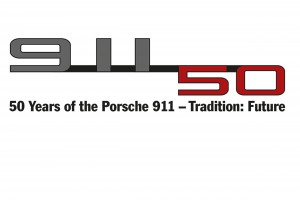



 Written by Graham Eason of
Written by Graham Eason of